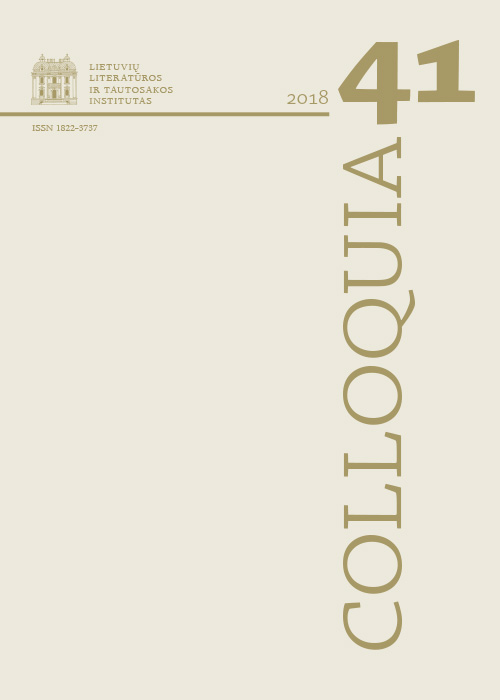Definitions and Discussions: Comparative Literature in the Interwar Lithuania
Abstract
After Lithuania won its independence, the geopolitical situation of the Lithuanian culture, which the philosopher Stasys Šalkauskis conceptualized as the synthesis of the Western and Eastern worlds, encouraged the openness of the national literature and its comparative research, which involved the most famous writers of that time. The academic publications by Kaunas University provided the first definitions of comparative literature and began to carry out comparative literary studies, most of which were influenced by historiographical works of Hippolyte Taine, Ch. A. Sainte-Beuve, George Brandes, Wilhelm Scherer, Wilhelm Dilthey, Oscar Walzel, Heinrich Wölfflin, and Fritz Strich.
Writer Balys Sruoga, who taught Russian literature at the University and, in his articles, referred to German historians and the most recent works by Russian comparativists Viktor Zhirmunsky and Alexander Veselovsky, employed the comparative-historical method. Ignas Skrupskelis, who presented his dissertation Lithuanians in the German Literature of the 18th century (Lietuviai XVIII amžiaus vokiečių literatūroje) at the University of Vienna in 1932, conceptualized comparative literature as a separate field of research. The authors of the Universal Literary History (Visuotinė literatūros istorija, in 2 parts, published in 1931 and 1932 respectively) emphasized the significance of typological research on literary genres and styles. Vincas Mykolaitis-Putinas and Julijonas Lindė-Dobilas were also concerned about organizing Lithuanian literature into „schemes of development of common European art“. Writer and critic Antanas Vaičiulaitis, who based on the latest research by French authors and presented in Lithuanian press La littérature comparée (1931), the most recent book by the then famous comparatist Paul van Tieghm, also published the first book on comparative literature, Naturalism and Lithuanian Literature (Natūralizmas ir lietuvių literatūra) in 1936.
In the interwar period in Lithuania, comparative literature was forming with the emphasis on the notion of artistic disinterest, which the scholars related mainly to genetic research and influences. They were interested in what motives or stylistic trends unite different writers and their works, because in that period, it was believed that literature could best help to know and describe the human nature and to consider the most important issues of national identity, as well as those common to all mankind. The comparative studies of Lithuanian literature that began in the interwar period looked up rapidly to European examples, but the Second World War, the Soviet occupation of the country and the mass emigration of its intelligentsia to the West led to their stagnation.
Downloads
Most read articles by the same author(s)
- Aušra Jurgutienė, Literatūros kanono dirbtuves aplankius , Colloquia: Vol. 51 (2023): Colloquia
- Aušra Jurgutienė, Comparative Literature Studies in Violeta Kelertas’s Literary Criticism , Colloquia: Vol. 55 (2025): Colloquia
- Jūratė Čerškutė, Aušra Jurgutienė, “We Not Only Construct but Also Deconstruct Our Lives with Stories” , Colloquia: Vol. 54 (2024): Colloquia
- Aušra Jurgutienė, A Few Thoughts About the New Histories of Polish and Latvian Literature , Colloquia: Vol. 53 (2024): Colloquia
- Aušra Jurgutienė, The Criticism of Vytautas Kubilius and Rimvydas Šilbajoris and the Ghost of Deconstruction , Colloquia: Vol. 37 (2016)
- Aušra Jurgutienė, Baltijos šalių konferencija – tarptautinė ar regioninė? , Colloquia: Vol. 32 (2014)
